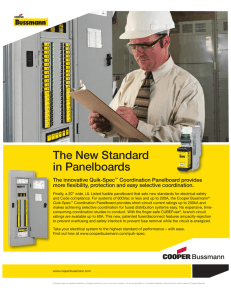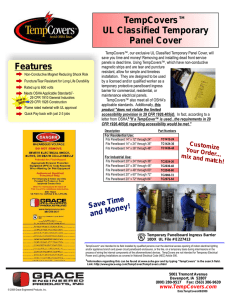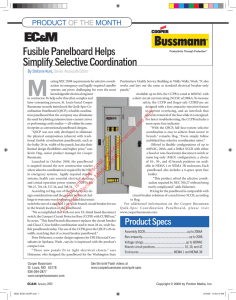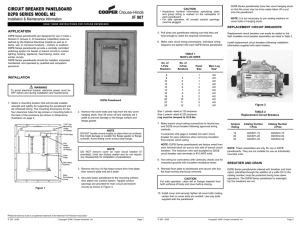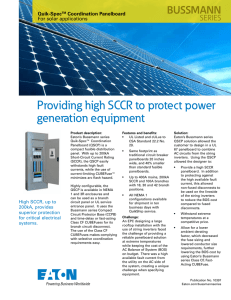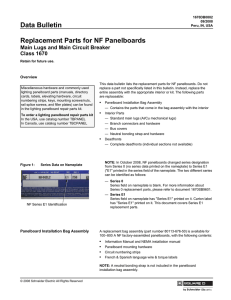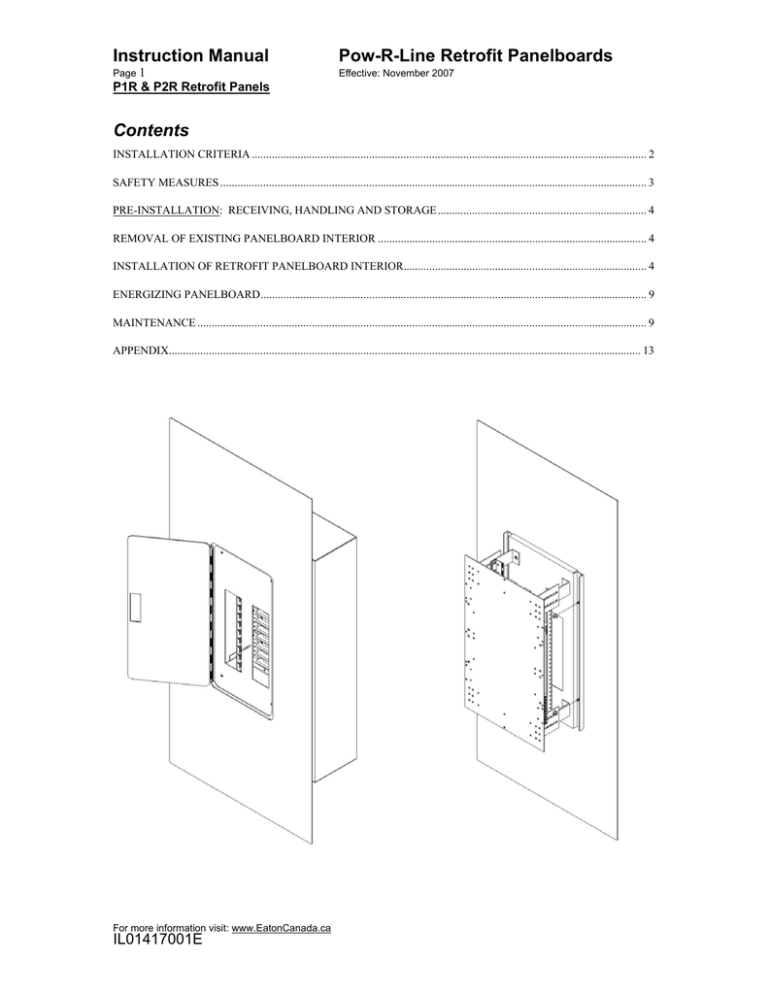
Instruction Manual
Pow-R-Line Retrofit Panelboards
Page 1
Effective: November 2007
P1R & P2R Retrofit Panels
Contents
INSTALLATION CRITERIA .......................................................................................................................................... 2
SAFETY MEASURES ..................................................................................................................................................... 3
PRE-INSTALLATION: RECEIVING, HANDLING AND STORAGE ......................................................................... 4
REMOVAL OF EXISTING PANELBOARD INTERIOR .............................................................................................. 4
INSTALLATION OF RETROFIT PANELBOARD INTERIOR..................................................................................... 4
ENERGIZING PANELBOARD....................................................................................................................................... 9
MAINTENANCE ............................................................................................................................................................. 9
APPENDIX..................................................................................................................................................................... 13
For more information visit: www.EatonCanada.ca
IL01417001E
Instruction Manual
Pow-R-Line Retrofit Panelboards
Page 2
Effective: November 2007
P1R & P2R Retrofit Panels
Installation Criteria
The Cutler-Hammer Pow-R-Line P1R & P2R panelboards are intended for use in the following
list of panelboard enclosures and which meet the minimum size requirements listed in the table
below.
P1RL & P1RB PANELBOARDS
100
100
100
225
225
225
60-100
60-100
60-100
60-225
60-225
60-225
Minimum
Height
(inches)
19.5
26.5
33.5
22
28
34
19.5
26.5
33.5
30
36
42
Minimum
Width
(inches)
14.25
14.25
14.25
14.25
14.25
14.25
14.25
14.25
14.25
14.25
14.25
14.25
Minimum
Depth
(inches)
4.5
4.5
4.5
4.5
4.5
4.5
4.5
4.5
4.5
4.5
4.5
4.5
400
400
400
48
48
48
20.0
20.0
20.0
5.75
5.75
5.75
Minimum
Width (in)
14.25
14.25
14.25
14.25
14.25
14.25
14.25
14.25
14.25
14.25
14.25
14.25
20.0
20.0
20.0
Minimum
Depth (in)
4.75
4.75
4.75
4.75
4.75
4.75
4.75
4.75
4.75
4.75
4.75
4.75
5.75
5.75
5.75
Main Device
Circuits
Current
Lug
Lug
Lug
Lug
Lug
Lug
Breaker (BAB)
Breaker (BAB)
Breaker (BAB)
Breaker (E or F Frame)
Breaker (E or F Frame)
Breaker (E or F Frame)
18
30
42
18
30
42
18
30
42
18
30
42
Lug
Lug
Lug
24
30
42
P2RL & P2RB PANELBOARDS
Main Device
Lug
Lug
Lug
Lug
Lug
Lug
Breaker (GBH, GHB)
Breaker (GBH, GHB)
Breaker (GBH, GHB)
Breaker (E or F Frame)
Breaker (E or F Frame)
Breaker (E or F Frame)
Lug
Lug
Lug
Circuits
18
30
42
18
30
42
18
30
42
18
30
42
24
30
42
Current
100
100
100
225
225
225
60-100
60-100
60-100
60-225
60-225
60-225
400
400
400
Minimum
Height (in)
19.5
26.5
33.5
22
28
34
19.5
26.5
33.5
30
36
42
48
48
48
For more information visit: www.EatonCanada.ca
IL01417001E
11/2007
Instruction Manual
Pow-R-Line Retrofit Panelboards
Page 3
Effective: November 2007
P1R & P2R Retrofit Panels
Safety Measures
This publication contains instructions on the
installation of Eaton Electrical Cutler-Hammer brand
Pow-R-Line low voltage distribution Panelboards.
Any person or persons that design, purchase, install,
operate or maintain new systems utilizing these
products must understand the equipment; it’s
markings and limitations.
Hazardous voltages in distribution panelboards and
all other electrical equipment pose a potential
hazard to life and property. Please follow
instructions, labeling and applicable codes and
standards for installation, maintenance and
operation of this equipment and its components.
Only “Qualified Persons” should install and/or
service this equipment. NFPA 70 – National
Electrical Code defines a “Qualified Person” as “One
who has skills and knowledge related to the
construction an operation of electrical equipment
and installations and has received safety training on
the hazards involved”. Standard symbols have been
established for recognition of potentially hazardous
situations and conditions. Please review and
understand the critical warning symbols shown
below. These symbols will appear on safety labels
affixed to the product. Installer should always read
and understand these labels before working on
equipment.
Eaton Corporation’s liability for any errors or
omissions in this document is limited to the
documentary correction of errors. Eaton Corp. will
not be responsible in any event for errors or
omissions in this document or for any damages,
incidental or consequential (including monetary
losses), that might arise from the use of this
document or the information contained in it.
Information in this publication is not intended for use
as a training manual for non-qualified personnel.
The information or statements in this publication
concerning the suitability, capacity or performance
of the panelboard(s) may not cover all configurations
of this custom built product. Eaton Electrical has
made all reasonable efforts to ensure that the
instructions in this document are adequate and free
of material errors and omissions. Eaton Electrical
will, if necessary, explain issues, which may not be
covered by the document. The information
contained in the Instruction Leaflet is subject to
change without notice.
Introduction
This instruction manual is designed to supplement
other industry standards including all local, state and
federal codes and safety regulations, such as
OSHA, NFPA 70 (National Electrical Code),
Canadian Electrical Code, NFPA 70E (Standard for
Electrical Safety Requirements for Employee
Workplaces, NEMATM PB2.1) General Instructions
for Proper Handling, Installation, Operation and
Maintenance of Dead-front Distribution Panelboards
Rated 600 Volts and Less, other workplace,
electrical installation requirements and all safety
rules.
Safety
Due to the weight and size of Panelboards and
dangers from electrical hazards, every precaution
should be taken to maintain safe working conditions
when handling this equipment. Due to the custom
nature of panelboards and the site variables, every
potential situation cannot be anticipated. Safety
must always be the overriding factor. Always follow
all instructions and all safety guidelines published by
OSHA and other industry and local, state and
federal agencies.
Symbol Meaning
The addition of either symbol to a “Danger” or
“Warning” safety label indicates that an electrical
hazard exists which will result in personal injury if
the instructions are not followed. This is the safety
alert symbol. It is used to alert you to potential
personal hazards. Obey all safety messages that
follow this symbol to avoid possible injury and death.
_ “DANGER” INDICATES AN
IMMINENTLY HAZARDOUS SITUATION
WHICH, IF NOT AVOIDED, WILL RESULT
IN DEATH OR SERIOUS INJURY.
“WARNING” INDICATES A POTENTIALLY
HAZARDOUS SITUATION WHICH, IF NOT
AVOIDED, CAN RESULT IN DEATH OR SERIOUS
INJURY.
“CAUTION” INDICATES A POTENTIALLY
HAZARDOUS SITUATION WHICH, IF NOT
AVOIDED, CAN RESULT IN MINOR OR
MODERATE INJURY.
“CAUTION”, USED WITHOUT THE SAFETY
ALERT SYMBOL, INDICATES A POTENTIALLY
HAZARDOUS SITUATION WHICH, IF NOT
AVOIDED, CAN RESULT IN PROPERTY
DAMAGE.
For more information visit: www.EatonCanada.ca
IL01417001E
11/2007
Instruction Manual
Pow-R-Line Retrofit Panelboards
Page 4
Effective: November 2007
P1R & P2R Retrofit Panels
Pre-Installation: Receiving,
Handling and Storage
Receiving
Upon delivery, use the packing list to confirm the
number of items against what was received to
ensure that the shipment is complete. Any
discrepancies should be noted on the freight bill
before signing. Report any shortages or damage to
the freight carrier immediately.
Immediately upon receipt of the panelboard interior
and trim, the packaging should be carefully removed
and a thorough inspection of each section should be
made to detect any damage incurred during
shipment. Any damage should be noted on the bill of
lading (freight bill) and the consignee receiving the
equipment should notify the freight carrier.
FAILURE TO NOTIFY THE FREIGHT CARRIER
OF DAMAGE IN A TIMELY MANNER MAY
RESULT IN THE CONSIGNEE ASSUMING THE
COSTS ASSOCIATED WITH REPAIR OR
REPLACEMENT OF DAMAGED EQUIPMENT.
After inspection, the components should be returned
to its packaging until it is ready for installation.
Handling
Depending on the configuration, panelboards may
weigh in excess of 100 pounds. Before moving or
lifting, verify that the panel is within safe limits of the
installers lifting capacity.
Removal of Existing
Panelboard Interior
DO NOT work on electrical equipment while
energized. Verify power entering the equipment is
de-energized at the source.
Follow appropriate lockout procedure to this panel
before starting work.
Electrical Disconnection of
Existing Panelboard
After panel has been de-energized and the feeder
device is locked out, removal procedure can begin.
Carefully identify all connections, load and line
paying particular attention to main incoming
phasing.
Identify correct phasing on the mains and
disconnect all phases, neutral and ground
connections.
Identify and disconnect all load wires (line & neutral)
connected to existing branch breakers, noting
current values. Before proceeding, it is important to
verify that the line and load cables (phase, neutrals
and grounds) are long enough to connect to the new
interior.
Proceed to disconnect all electrical connections
attached to the existing interior. Once the
conductors are disconnected from the old interior,
the cables should be formed in the space provided.
Care should be taken in forming insulated cables to
ensure that no insulation is forced permanently
against the edges of any metal parts.
Removal of Existing Interior
Panelboards, which cannot be immediately installed
and energized, should be stored in an indoor dry,
clean and heated environment.
Do not store in areas where conditions such as
dampness, changes in temperature, cement dust or
a corrosive atmosphere is present.
Remove all chassis mounting hardware. Carefully
remove chassis to ensure that cable insulation is not
damaged by sharp edges.
To allow for adequate bonding, all attempts should
be made to utilize existing mounting studs/system in
the enclosure.
If it is not feasible to use existing mounting system,
remove all protrusions to allow for a flat mounting
surface.
HAZARDOUS VOLTAGE. WILL CAUSE SEVERRE INJURY
OR DEATH.
Installation of RetroFit
Panelboard Interior
Storage
ONLY THOSE PROFESSIONALS TRAINED AND
QUALIFIED ON ELECTRICAL DISTRIBUTION
PANELBOARDS SHOULD INSTALL AND/OR SERVICE
THIS EQUIPMENT
Removal of Dead-front cover
Remove the interior from packaging.
Place on a solid work surface, remove qty 4 ¼-20
screws that fasten the dead-front cover to the
chassis – (see Fig. A). Place dead-front cover and
hardware in a safe location to prevent damage.
For more information visit: www.EatonCanada.ca
IL01417001E
11/2007
Instruction Manual
Pow-R-Line Retrofit Panelboards
Page 5
Effective: November 2007
P1R & P2R Retrofit Panels
Fig. A
Locating Interior Mounting Holes in
Enclosure
In most instances the chassis should be centered in
the enclosure unless a special offset trim has been
ordered. Measure and draw vertical and horizontal
centerlines.
Using these marks, support the interior in the
enclosure and mark the 4 holes that are located on
the center axis. See figure below.
Re-verify that all electrical conductors long enough
to be terminated properly.
Ensure main incoming cables are long enough to
reach Main and Neutral termination locations without
compromising wire bending space requirements as
listed in the Appendix, Table 1.
Ensure that electrical clearance requirements are
maintained per NECTM/CECTM.
Care must be taken to ensure that the trim will
completely cover openings in the enclosure.
If not using existing mounting hardware, mark
minimum of 8 mounting locations, on the back of the
enclosure. Drill and tap 10-32 holes as per Fig. B
Fig. C
Loosen qty 8 10-32 screws Fig. D installed on the
chassis corners.
Fig. D
Set chassis depth by aligning bottom edge
of interior mounting rail with the appropriate
depth as determined by the measurement
obtained inn the previous step. Torque
#10-32 screws to 24 in lbs.
Fig. B
Determine proper depth setting
To determine preset depth of the chassis, place a
non-conducting, insulated straight edge across the
finished wall surface and measure to the rear of the
enclosure. See Fig. C
For more information visit: www.EatonCanada.ca
IL01417001E
11/2007
Instruction Manual
Pow-R-Line Retrofit Panelboards
Page 6
Effective: November 2007
P1R & P2R Retrofit Panels
Install Interior
Install interior using mounting holes drilled and
tapped in previous steps using supplied 10-32
hardware.
Fig. E
Verify Interior depth adjustment - Using a nonconducting, insulated straight edge, verify dimension
from the front surface of the dead-front cover
mounting bracket. This should not be less than
11/16” (0.6875”). See Fig. E. If adjustments are
required, remove interior and readjust depth as per
previous steps.
the full length of the lug body. Tighten lug, then
torque to levels indicated on the panelboard label.
If compression lugs are utilized and supplied with
the panelboard, the lugs will be mounted on the
incoming lug pad. Remove lugs from the pad. Use
an antioxidant compound, if required. Use a
crimping tool approved for that specific lug
manufacturer and lug size.
Follow instructions provided by the manufacturer of
the crimp tool. Once the lug is affixed to the
conductor, re-install the lug on the lug pad utilizing
the existing hardware. Torque hardware using
information provided in Appendix - Table 2 for
torque values.
To ensure retrofit interior mounting pan is sufficiently
bonded to ground, a minimum of 1 existing mounting
stud should be used to mount the chassis. If this is
not feasible, install the supplied bonding wire and
lug to assembly between one of the chassis ground
bars to the enclosure. You may be required to drill
and tap a #10-32 hole. Use hardware supplied with
interior.
Connect all load grounds
Connect all load neutrals.
Connect all loads
Trim Installation
Install dead-front cover to the rear of trim with
supplied #10-32 Keps nuts. See Fig. F. Verify door
opens in desired direction
Installation of Incoming
Panelboard Connections
Main incoming connections (mains, neutral and
ground).
Note: As a minimum, all panelboard connections
are rated for use with 75°C or higher rated
conductors. When wire is used with temperature
ratings above 75°C, it shall be sized based on the
ampacity of wire rated 75°C.
Fig. F
Install trim and dead-front cover as one assembly
using qty 4 ¼-20 X 0.75” screws.
Wire/Cabling
Mechanical setscrew lugs are typically supplied for
incoming cable connection.
Using appropriate tools, the installer must strip the
conductor insulation sufficiently to fill the entire
barrel of the connector with bare, non-insulated
conductor.
Conductor must be stripped without damage to the
conductor strands. Bare strands should be of equal
length (flush) on the end cut. Do not strip off more
insulation than needed. Exposure of bare conductor
outside lug can compromise clearances. The
connector and conductor should be free of all
foreign debris.
Never clip cable/wire strands in order to fit within
connectors. If cable/wire does not match the rating
of the connector, contact the manufacturer.
Use an antioxidant compound, if required. Insert
bare conductor into lug so the bare conductor fills
Fig. G
Install directory cardholder, and Latch. Trim number
strip to the appropriate length and install on
Deadfront cover.
For more information visit: www.EatonCanada.ca
IL01417001E
11/2007
Instruction Manual
Pow-R-Line Retrofit Panelboards
Page 7
Effective: November 2007
P1R & P2R Retrofit Panels
8.
Fig. H
Transfer all pertinent information from the old
directory card to the new card and insert in holder.
Pre-Energizing Procedures and
Inspection
Before energizing any panelboard, perform a
comprehensive inspection to make certain that the
panelboard is ready to be energized. This includes
the following steps:
1.
2.
3.
4.
5.
6.
7.
Verify that the panelboard is not
energized.
Visually inspect the panelboard and
remove all foreign materials, such as,
tools, scraps of wire and other debris
from all panelboard sections.
Remove and discard all packing
materials and temporary shipping
braces from the panelboard.
Any accumulation of dust and dirt
should be removed with a vacuum
cleaner. Use a lint-free cloth to remove
dust and dirt on other surfaces. Never
use compressed air as this may blow
contaminants into electrical and/or
electronic components. Never use
solvents or other chemicals to clean
surfaces or components.
Visually inspect all ventilation points to
ensure that there is no blockage or
debris. Remove all debris, if present.
Verify all field wire connections have
the proper torque per instructions on the
panelboard and on components.
All factory connections are made
utilizing calibrated power tools.
However, vibrations do occur in transit
and handling. Verify factory
connections by checking at least 10% of
the total factory connections for
tightness. If this spot check reveals
loose connections, proceed to check all
factory connections. These connections
include bus hardware connections,
circuit breaker terminals, and other
connections, including the incoming
terminals.
Visually inspect panelboard insulators,
bus bar and conductors for damage. DO
NOT ENERGIZE IF DAMAGE IS
FOUND. Contact Eaton Electrical.
Circuit Breakers
Circuit breakers are typically shipped in either the
open (OFF) or “tripped” position. Manually close,
and then open these devices to ensure they are
functioning properly. At the completion of this
process, be sure that the circuit breaker is in the
“OFF” or “tripped” position. Inspect circuit breakers
for any visible damage.
If damage is found, DO NOT ENERGIZE the
panelboard. Contact Eaton Electrical.
Overcurrent Devices with Ground
Fault Protection
This panelboard may contain overcurrent devices
with Ground Fault Protection (GFP). The National
Electrical Code may require ground fault protection
for this installation. Other GFP applications may be
used including multi-level ground fault protection.
Refer to the panelboard drawings and electrical
construction drawings for usage and placement
within the panelboard.
Ground fault protection may be installed integral to
overcurrent device(s) or as a separate system.
Separate systems typically are connected to a shunt
tripping mechanism on an overcurrent device.
Visibly inspect connections on GFP systems, neutral
sensors and ground connections. Refer to
manufacturer’s instructions for details.
The National Electrical Code, Article 230-95 requires
that any GFP systems must be performance tested
when first installed. Conduct tests in accordance
with the approved instructions provided with the
equipment. A written test report must be available
for the Authority Having Jurisdiction (AHJ). Refer to
the National Electrical Code for specific requirement
or contact Eaton Electrical. Field-testing of ground
fault protection must follow instructions provided
with each GFP device. Due to the varied types of
GFP systems, testing instructions can vary from
device to device. Refer to the specific testing
instructions for each device. Refer to instruction
For more information visit: www.EatonCanada.ca
IL01417001E
11/2007
Instruction Manual
Pow-R-Line Retrofit Panelboards
Page 8
Effective: November 2007
P1R & P2R Retrofit Panels
leaflets that are shipped with each panelboard
containing GFP or contact Eaton Electrical.
Preparing Panelboard for
Insulation/Megger Testing
Devices Installed with Control Power
Fusing
Devices, which require control power fusing, can be
easily damaged beyond repair if not disconnected
during the testing phase. These devices include, but
are not limited to, customer metering equipment,
electronic breaker trip units, motor operators and
communication equipment. Prior to testing the
panelboard, turn off all control power devices in the
panelboard to prevent damage to components. The
control power may be turned off by utilizing the
control power switch or by removing the fuses.
Components that use power supplies include
customer metering and certain breaker accessories
and these must be isolated before testing.
TO PREVENT DAMAGE TO GROUND FAULT
CONTROL CIRCUITS, METERING CIRCUITS,
TRANSIENT VOLTAGE SURGE PROTECTION
(TVSS) OR OTHER CONTROL CIRCUITS, WHEN
MEGGERING PANELBOARD, ISOLATE
CIRCUITS FROM PANELBOARD SYSTEM
BEFORE BEGINNING THE MEGGER
OPERATION. BE SURE TO RECONNECT THOSE
CIRCUITS AFTER MEGGER TESTS ARE
COMPLETED.
NOTE: SOME GROUND FAULT CIRCUITS MAY
NOT BE FUSED, THEREFORE ISOLATION OF
THOSE CIRCUITS REQUIRES DISCONNECTING
WIRING FROM BUS BARS.
DISCONNECT POWER AT SOURCE BEFORE
REMOVING OR INSTALLING FUSES.
HAZARDOUS VOLTAGE. WILL CAUSE SEVERE
INJURY OR DEATH.
Failure to disconnect control power during
panelboard testing will result in failure of
electronic components and void manufacturer’s
warranty.
Pre-Energizing Panelboard
Insulation Testing
Exercise extreme care to prevent the
equipment from being connected to the power
source while tests are being conducted.
Prior to energizing the panelboard, perform a
Megger or DC test of the panelboard’s insulation
with the neutral isolated from the ground and the
switches and/or circuit breakers open, conduct
electrical insulation resistance tests from phase to
phase, phase to ground, phase to neutral, and
neutral to ground. Retain results for use to compare
to results produced in the future. Prior to testing,
remove all control power fusing and connections to
products, which will be damaged in this test. See
above.
DO NOT USE AC Dielectric
testing.
Test resulting in readings at or above 1 megaohm
is satisfactory.
Post-Testing
After testing, and with the panelboard de-energized,
reconnect all devices, control fusing and
disconnects removed prior to testing.
DO NOT TEST A CIRCUIT BREAKER WHILE IT’S
IN SERVICE AND ENERGIZED.
TESTING OF A CIRCUIT BREAKER THAT
RESULTS IN THE TRIPPING OF THE CIRCUIT
BREAKER SHOULD BE DONE ONLY WHEN THE
PANELBOARD IS DE-ENERGIZED.
FAILURE TO SHORT OR DISCONNECT DURING
PANELBOARD TESTING WILL RESULT IN
FAILURE OF ELECTRONIC COMPONENTS.
Securing the Panelboard
Install the dead front cover and trim parts on the
panelboard using hardware supplied by the
manufacturer. Take caution that conductors are not
pinched between parts when installing the deadfront cover and trim. All parts should be aligned and
secured when installed.
Do not leave holes or gaps in the dead-front
construction.
Clean up any debris in and around the panelboard.
FAILURE TO DISCONNECT CONTROL POWER
DURING PANELBOARD TESTING WILL RESULT
IN FAILURE OF ELECTRONIC COMPONENTS.
For more information visit: www.EatonCanada.ca
IL01417001E
11/2007
Instruction Manual
Pow-R-Line Retrofit Panelboards
Page 9
Effective: November 2007
P1R & P2R Retrofit Panels
TO PREVENT
DAMAGE TO GROUND FAULT
CONTROL CIRCUITS, METERING CIRCUITS, OR
OTHER CONTROL CIRCUITS WHEN
MEGGERING PANELBOARD, ISOLATE
CIRCUITS FROM
PANELBOARD SYSTEM BEFORE BEGINNING
THE MEGGER OPERATION. BE SURE TO
RECONNECT THOSE CIRCUITS AFTER
MEGGER TESTS ARE COMPLETED. NOTE:
SOME GROUND FAULT CIRCUITS MAY NOT BE
FUSED, THEREFORE ISOLATION OF THOSE
CIRCUITS REQUIRES
DISCONNECTING WIRING FROM BUS BARS.
device. Inspection and test operations should be
coordinated with an overall testing program to result
in the least operating inconvenience and system
shutdowns.
Prior to performing any maintenance on the
panelboard, first de-energize the panelboard at
the source. Use lockout/ tag-out precautions as
prescribed in OSHA, NFPA 70E and other safety
manuals.
The panelboard should be given a thorough
maintenance check annually.
Exercise extreme care to prevent the equipment
from being connected to the power source while
tests are being conducted.
DO NOT USE AC DIELECTRIC/MEGGER
TESTING.
Energizing Panelboard
Extreme hazards can exist when energizing
electrical distribution equipment and panelboards.
Take all precautions necessary to protect people
and property when energizing the equipment. Short
circuits and ground faults may exist as a result from
inadequate installation. Short circuits and ground
faults within the panelboard can cause catastrophic
damage, injury and death.
1.
2.
3.
4.
5.
Determine and always use proper Personnel
Protective Equipment (PPE) per NFPA
70E.
Prior to energizing the panelboard, turn OFF
all overcurrent devices and loads internal to
the panelboard plus mains in downstream
equipment.
Verify and follow the sequence of
energizing circuits and loads. Verify phase
sequencing on loads, such as motors, which
can be damaged or destroyed by incorrect
phase connections.
If provided, use remote operators to close
and energize panelboard, overcurrent
devices and loads.
Beginning with the main(s), turn ON each
overcurrent device.
Maintenance
It is essential to maintain the equipment in
satisfactory condition.
To ensure continued quality service, a systematic
maintenance schedule is vital. Facility operation and
local conditions vary to such an extent that the
schedule must be prepared to suit the conditions.
The maintenance schedule for individual devices,
such as circuit breakers, meters, fusible switches,
etc., should be based upon recommendations
contained in the individual instruction leaflet for each
For more information visit: www.EatonCanada.ca
IL01417001E
11/2007
Instruction Manual
Pow-R-Line Retrofit Panelboards
Page 10
Effective: November 2007
P1R & P2R Retrofit Panels
Maintenance after Cleaning
HAZARDOUS VOLTAGE. WILL CAUSE SEVERE
INJURY OR DEATH.
ONLY THOSE PROFESSIONALS TRAINED AND
QUALIFIED ON ELECTRICAL DISTRIBUTION
PANELBOARDS SHOULD INSTALL AND/OR
SERVICE THIS EQUIPMENT.
HAZARDOUS VOLTAGE WILL CAUSE SEVERE
INJURY OR DEATH. DE-ENERGIZE
PANELBOARD PRIOR TO SERVICING.
ONLY THOSE PROFESSIONALS TRAINED AND
QUALIFIED ON ELECTRICAL DISTRIBUTION
PANELBOARDS SHOULD INSTALL AND/OR
SERVICE THIS EQUIPMENT.
Panelboard Insulation Resistance
Testing
After cleaning, perform a second Megger or DC test
of the panelboard insulation between phases and
ground. Prior to testing, remove all control power
fusing and connections to products, which will be
damaged in this test. This includes all components
with control wire fusing, Transient Voltage Surge
Suppression, Surge Protective Devices, metering
equipment, etc.
DO NOT USE AC dielectric testing.
Test resulting in readings at or above 1 megaohm is
satisfactory.
Compare these test readings with prior readings and
retain with previous testing for future comparisons.
Trends of lowered insulation resistance are signs of
potential problems.
Bus and Cable Connections
1.
2.
3.
Maintenance before Cleaning
Prior to cleaning, perform an initial Megger or DC
test of the panelboard insulation, between phases
and ground. Inspect for symptoms that may indicate
overheating or weakened insulation. Record test
readings. Refer to NEMA publication AB-4
“Guidelines for Inspection and Preventative
Maintenance of Molded Case Circuit Breakers Used
in Commercial and Industrial Application.” Prior to
testing, remove all control power fusing and
connections to products, which will be damaged in
this test. This includes all components with control
wire fusing, Transient Voltage Surge Suppression,
Surge Protective Devices, metering equipment, etc.
4.
Inspect bus bar and cables for visible
damage.
Visually inspect connections for overheating
and damage.
All bus bars and cable connections should
be checked and torque in accordance with
labeling on the panelboard. Refer to
Appendix Table 2 for torque values.
Inspect for broken wire strands and pinched
or damaged insulation on cable connections.
Insulation
All bus bar and structure insulation in the
panelboard including bus supports, bus shields, bus
bracing, insulating barriers, etc., should be visually
checked for damage. Replace damaged parts. The
life of insulation material is dependent on keeping
the material dry and clean.
Cleaning
While the panelboard is de-energized, remove dust
and debris from bus bars, connections, supports and
enclosure surfaces. A vacuum cleaner with a nozzle
will be of assistance. Wipe clean with a lint-free
cloth. Do not use solvents to clean equipment as
damage to surfaces can occur. Should the
panelboard be exposed to adverse conditions, such
as, airborne contaminants, more frequent
inspections and cleaning may be required.
Use of compressed air to clean or blow out debris in
panelboards may imbed the contaminants within
overcurrent devices, metering equipment and other
components. Damage to insulation and other
surface materials can occur. Do Not Use
Compressed Air in cleaning.
TO PREVENT DAMAGE TO GROUND FAULT
CONTROL CIRCUITS, METERING CIRCUITS,
TRANSIENT VOLTAGE SURGE PROTECTION
(TVSS) OR OTHER CONTROL CIRCUITS, WHEN
MEGGERING PANELBOARD, ISOLATE
CIRCUITS FROM PANELBOARD SYSTEM
BEFORE BEGINNING THE MEGGER
OPERATION. BE SURE TO RECONNECT THOSE
CIRCUITS AFTER MEGGER TESTS ARE
COMPLETED.
NOTE: SOME GROUND FAULT CIRCUITS MAY
NOT BE FUSED, THEREFORE ISOLATION OF
THOSE CIRCUITS REQUIRES DISCONNECTING
WIRING FROM BUS BARS.
DO NOT USE ALTERNATING CURRENT (AC)
DIELECTRIC/MEGGER TESTING. DAMAGE TO
COMPONENTS WILL OCCUR.
For more information visit: www.EatonCanada.ca
IL01417001E
11/2007
Instruction Manual
Pow-R-Line Retrofit Panelboards
Page 11
Effective: November 2007
P1R & P2R Retrofit Panels
Panelboard Events and Service
Interruptions
DO NOT USE COMPRESSED AIR TO CLEAN OR
BLOW OUT DEBRIS OR DUST IN
PANELBOARDS.
TO PREVENT DAMAGE TO GROUND FAULT
CONTROL CIRCUITS, METERING CIRCUITS,
TRANSIENT VOLTAGE SURGE PROTECTION
(TVSS) OR OTHER CONTROL CIRCUITS, WHEN
MEGGERING PANELBOARD, ISOLATE
CIRCUITS FROM PANELBOARD SYSTEM
BEFORE BEGINNING THE MEGGER
OPERATION. BE SURE TO RECONNECT THOSE
CIRCUITS AFTER MEGGER TESTS ARE
COMPLETED.
NOTE: SOME GROUND FAULT CIRCUITS MAY
NOT BE FUSED, THEREFORE ISOLATION OF
THOSE CIRCUITS REQUIRES DISCONNECTING
WIRING FROM BUS BARS.
DO NOT USE ALTERNATING CURRENT (AC)
DIELECTRIC/MEGGER TESTING. DAMAGE TO
COMPONENTS WILL OCCUR.
Secondary Wiring
Check all wiring connections for tightness, including
those at the current and potential transformers, if
present, and at all terminal blocks. Check all
secondary wiring connections to ensure they are
properly connected to the panelboard ground bus,
where indicated. Look for broken wire strands and
pinched or damaged insulation.
Short-Circuits, Ground-Faults and
Overloads
A thorough assessment, identification and correction
of the event origin must be completed. An additional
assessment of the conductor insulation and other
insulating materials should be made. Replace all
damaged insulation materials, conductors and
overcurrent devices. Original panelboard parts,
insulators, insulation material and overcurrent
devices must be replaced with renewal parts from
Eaton Electrical. (See Renewal Parts Page 19.)
Do not attempt to re-energize panelboard
overcurrent components after electrical events,
such as short-circuits, ground-faults and
overloads, until the cause of the event
has been identified and corrected.
After the event has been rectified, test
equipment per the maintenance process
described in this publication.
Physical Damage
Any physical damage to the panelboard that occurs
after the panelboard is installed must be corrected.
A thorough inspection, which includes the exterior
enclosure and dead-front, plus interior components
in the damaged portion of the panelboard, should be
conducted. Replace all damaged parts and
components. Ensure that there are no gaps in the
panelboard enclosure that could cause exposure to
live parts. Contact Eaton Electrical for renewal parts
and assistance. After the physical damage has
been corrected, test equipment per the maintenance
process described in this publication.
Ventilation
Check all grills and ventilation ports for obstructions
and accumulations of dirt. Clean ventilation ports, if
necessary. For panelboards installed outdoors,
inspect the air space under the panelboard to be
sure that it is clean and clear of debris, leaves and
obstructions.
Records
It is essential to maintain the equipment in
satisfactory condition.
Maintain a permanent record of all maintenance
activities and testing for future reference. The
condition of each panelboard should be recorded as
a guide for anticipating the need for any
replacement parts or components or special
attention at the next regular maintenance period. It
is recommended that a series of inspections be
made at quarterly intervals until the progressive
effects of local conditions can be analyzed to
determine a regular schedule.
HAZARDOUS VOLTAGE WILL CAUSE SEVERE
INJURY OR DEATH. DE-ENERGIZE BOARD
PRIOR TO SERVICING FUSIBLE DEVICES.
NEVER USE COMPRESSED AIR TO CLEAN OR
BLOW OUT DEBRIS OR DUST IN
PANELBOARDS.
DO NOT ATTEMPT TO RE-ENERGIZE
PANELBOARD OVERCURRENT DEVICES
AFTER ELECTRICAL EVENTS, SUCH AS
SHORT-CIRCUITS, GROUND-FAULTS AND
OVERLOADS,
UNTIL THE CAUSE OF THE EVENT HAS BEEN
IDENTIFIED AND CORRECTED.
For more information visit: www.EatonCanada.ca
IL01417001E
11/2007
Instruction Manual
Pow-R-Line Retrofit Panelboards
Page 12
Effective: November 2007
P1R & P2R Retrofit Panels
Water Damage
DO NOT WORK ON SURFACES OR FLOORS
WHERE THERE IS STANDING WATER.
DO NOT WORK ON WET ENERGIZED
ELECTRICAL
EQUIPMENT.
Major accumulation of water or moisture on any
part of the panelboard can cause catastrophic
damage to the panelboard. If a panelboard has
been submerged by more than 2 inches or where
running or standing water has had contact with
current carrying parts, it has sustained significant
damage.
The panelboard and its components may be
damaged beyond repair and may need replacement.
1.
2.
3.
4.
Do not attempt to clean or repair
water-damaged equipment or
components.
De-energize the panelboard at its
source.
Do not energize.
Contact Eaton Electrical for
replacement.
the availability of obsolete equipment or parts.
Equipment replacement may be recommended.
WET PANELBOARDS PRESENT A HAZARDOUS
CONDITION AND MAY CAUSE INJURY OR
DEATH. DE-ENERGIZE POWER TO ALL
EQUIPMENT BEFORE SERVICING.
DO NOT WORK ON PANELBOARDS OR ENTER
AREAS THAT HAVE STANDING WATER. DEENERGIZE ALL EQUIPMENT IN AREAS WITH
STANDING WATER.
PANELBOARD COMPONENTS, INCLUDING
CIRCUIT BREAKERS, FUSIBLE SWITCHES,
METERING, ETC., SUBJECTED TO WATER OR
MOISTURE MAY BE RENDERED UNSAFE.
REPLACEMENT IS REQUIRED.
Minor accumulations of moisture, such as
condensation, over a short period of time may be
corrected using heat. De-energize panelboard.
Apply approximately 250 watts per vertical section
for a sufficient period of time until the moisture
disappears, then remove all heat sources and
materials used for drying. Inspect for damage to
components and any corrosion. If any damage or
corrosion is present, contact Eaton Electrical. DO
NOT RE-ENERGIZE PANELBOARD. After the
panelboard has completely dried, remove all
materials and tools from the equipment. Inspect all
connections for damage and torque. Re-install all
covers, fillers, dead-front assemblies and side
sheets. Conduct panelboard insulation resistance
testing described in this publication.
Renewal Parts
To ensure safety and to maintain ULTM listing and
CSATM approval, it is essential that only new parts
and components from Eaton Electrical be utilized.
When ordering renewal parts or when requesting
information on the panelboard, it is essential to
include as much information as possible.
Each panelboard will have a nameplate and other
identification marks with details that will help
expedite information requests and orders. The
following may be required to help identify parts and
information requests.
■___ Catalog number of the panelboard
■___ Description of the equipment
■___ Supply voltage
■___ Equipment ratings
■___ Description of the part
■___ Style number of part, if available
■___ Rating of part(s)
Electrical distribution equipment has a limited life
span. As such, the manufacturer cannot guarantee
For more information visit: www.EatonCanada.ca
IL01417001E
11/2007
Instruction Manual
Pow-R-Line Retrofit Panelboards
Page 13
Effective: November 2007
P1R & P2R Retrofit Panels
Appendix
Table 1
Wire bending space requirements
Wire Size
(AWG)
#3
#2
#1
#1/0
#2/0
3/0
4/0
250MCM
Main Breaker
Interior
2”
2.5”
3”
5”
6”
6.5”
7”
8”
Main Lug
Interior
2”
2.5”
3”
5”
6”
6”
6”
6.5”
Table 2
Torque Values for Copper or Aluminum Bus Bar Connections
Bolt Size
#10
¼”
5/16”
3/8”
½”
Torque Inch Lbs
30
65
130
240
600
Torque Foot Lbs
2.5
5.4
10.8
20
50
National Electrical Code and NEC are registered trademarks of the National Fire Protection Association, Quincy,
Mass. UL is a federally registered trademark of Underwriters Laboratories Inc. NEMA is the registered trademark
and service mark of the National Electrical Manufacturers Association. Canadian Electrical Code, CEC, and CSA
are registered trademarks of the Canadian Standards Association, Toronto, Ontario.
For more information visit: www.EatonCanada.ca
IL01417001E
11/2007
Instruction Manual
Pow-R-Line Retrofit Panelboards
Page 14
Effective: November 2007
P1R & P2R Retrofit Panels
Notes
© 2007 Eaton Corporation
All Rights Reserved
Printed in Canada
Publication No. PUB50895
November 2007
Eaton Yale Company
5050 Mainway
Burlington, On L7L 5Z1
CANADA
tel: 1-800-268-3578
www.Eaton.com
For more information visit: www.EatonCanada.ca
IL01417001E
11/2007

